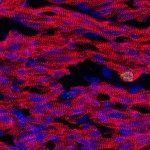Lien vers Pubmed [PMID] – 22955731
Circ. Res. 2012 Oct;111(10):1323-35
RATIONALE: The second heart field (SHF) contains progenitors of all heart chambers, excluding the left ventricle. The SHF is patterned, and the anterior region is known to be destined to form the outflow tract and right ventricle.
OBJECTIVE: The aim of this study was to map the fate of the posterior SHF (pSHF).
METHODS AND RESULTS: We examined the contribution of pSHF cells, labeled by lipophilic dye at the 4- to 6-somite stage, to regions of the heart at 20 to 25 somites, using mouse embryo culture. Cells more cranial in the pSHF contribute to the atrioventricular canal (AVC) and atria, whereas those more caudal generate the sinus venosus, but there is intermixing of fate throughout the pSHF. Caudal pSHF contributes symmetrically to the sinus venosus, but the fate of cranial pSHF is left/right asymmetrical. Left pSHF moves to dorsal left atrium and superior AVC, whereas right pSHF contributes to right atrium, ventral left atrium, and inferior AVC. Retrospective clonal analysis shows the relationships between AVC and atria to be clonal and that right and left progenitors diverge before first and second heart lineage separation. Cranial pSHF cells also contribute to the outflow tract: proximal and distal at 4 somites, and distal only at 6 somites. All outflow tract-destined cells are intermingled with those that will contribute to inflow and AVC.
CONCLUSIONS: These observations show asymmetric fate of the pSHF, resulting in unexpected left/right contributions to both poles of the heart and can be integrated into a model of the morphogenetic movement of cells during cardiac looping.


